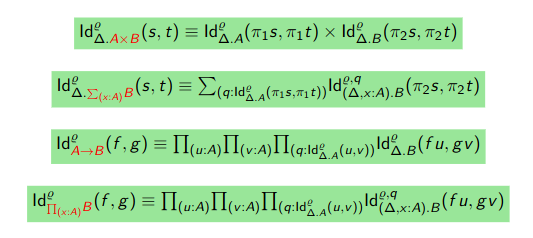This question is based on the talks given by Mike Shulman on higher observational type theory (part 1, part 2, part 3).
In trying to understand the reduction rules of the calculus, I tried to work through some examples using the rules present on slide 7 in part 2 (I've copied in a screenshot below, and am assuming there's a missing $\Delta$ on the LHS for the dependent product/function case, but I could be wrong):
The below example gave me some trouble, however: It seems that the variable $x$ can 'escape' it's scope:
\begin{aligned} &Id_{Δ.((Π (x : A) (y : B\:x). C))}^δ(f, g)\\ ≡ &\Pi (u, v : A). \Pi(p: Id_{Δ.A}^δ (u, v)).\: (Id_{(Δ, x:A).(Π (y : B\:x). C)}^{δ, p} (f\: u, g\: v))\\ ≡ &\Pi (u, v : A) (p: Id_{Δ.A}^δ (u, v)) (m, n : B\: x) (q : Id_{(Δ, x:A).B}^{δ,p}(m, n)). Id_{(Δ, x:A, y:B).C}^{δ, p, q} (f\: u\: m, g\: v\: n) \end{aligned}
My question basically boils down to: what went wrong here? Am I misinterpreting the rules? Is there a typo on the slides?
Any help would be greatly appreciated.
